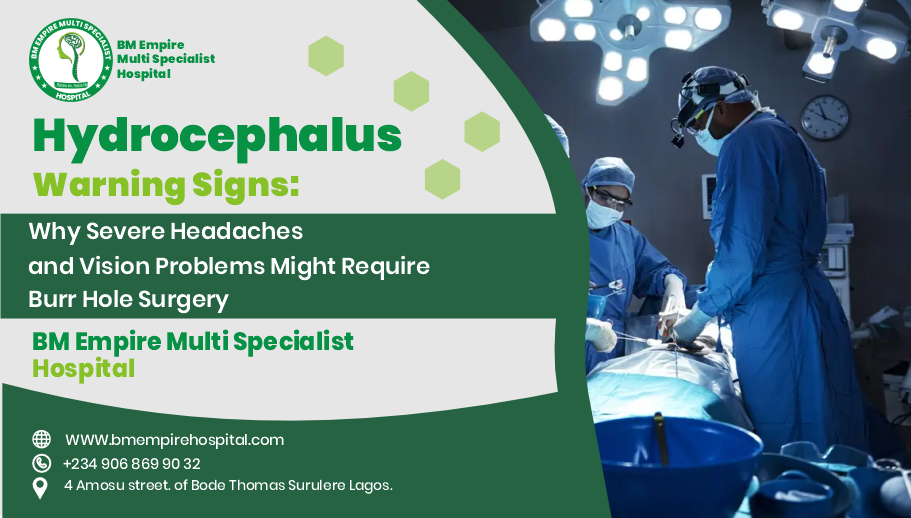Hydrocephalus, often referred to as “water on the brain,” is a serious medical condition characterized by the buildup of cerebrospinal fluid (CSF) in the brain. This excess fluid can increase pressure inside the skull, leading to potentially life-threatening complications if left untreated. Recognizing the warning signs of hydrocephalus is crucial for timely intervention. At BM Empire Multispecialist Hospital, Lagos’ leading neurosurgery hospital, we specialize in diagnosing and treating hydrocephalus, including advanced procedures like burr hole surgery. In this article, we’ll explore the warning signs of hydrocephalus, why it requires prompt medical attention, and how burr hole surgery can be a life-saving solution.
What is Hydrocephalus?
Hydrocephalus occurs when there is an imbalance between the production and absorption of cerebrospinal fluid (CSF). This fluid, which normally cushions the brain and spinal cord, can accumulate in the brain’s ventricles, causing increased intracranial pressure. The condition can affect individuals of all ages, from infants to older adults, and may result from:
- Congenital defects.
- Infections such as meningitis.
- Brain tumors or cysts.
- Head injuries or trauma.
- Hemorrhages or strokes.
Warning Signs of Hydrocephalus
The symptoms of hydrocephalus can vary depending on the age of the patient and the progression of the condition. Here are some common warning signs to watch out for:
In Infants:
- Rapidly enlarging head size: A noticeable increase in the circumference of the baby’s head.
- Bulging fontanelle: The soft spot on the baby’s skull may appear swollen or tense.
- Vomiting and irritability: Persistent fussiness and feeding difficulties.
- Developmental delays: Slower progress in reaching milestones like sitting or crawling.
In Children and Adults:
- Severe headaches: Often worse in the morning or after lying down.
- Vision problems: Blurred or double vision due to pressure on the optic nerve.
- Nausea and vomiting: Especially when accompanied by headaches.
- Difficulty walking or balancing: Unsteady gait or frequent falls.
- Cognitive decline: Memory loss, confusion, or difficulty concentrating.
- Seizures: In severe cases, increased intracranial pressure can trigger seizures.
In Older Adults:
- Urinary incontinence: Loss of bladder control.
- Slowed movements: Difficulty initiating or completing tasks.
- Dementia-like symptoms: Memory loss, apathy, or personality changes.
Why Severe Headaches and Vision Problems Are Red Flags
Severe headaches and vision problems are among the most critical warning signs of hydrocephalus. These symptoms indicate increased intracranial pressure, which can damage brain tissue and lead to permanent neurological deficits if not addressed promptly. If you or a loved one experiences these symptoms, seek immediate medical attention.
Diagnosing Hydrocephalus
At BM Empire Multispecialist Hospital, our team uses advanced diagnostic tools to confirm hydrocephalus, including:
- CT Scans: To visualize the brain’s ventricles and detect fluid buildup.
- MRI Scans: To provide detailed images of the brain and identify underlying causes.
- Lumbar Puncture: To measure CSF pressure and analyze its composition.
Burr Hole Surgery: A Lifesaving Solution
When hydrocephalus is diagnosed, timely treatment is essential to relieve pressure on the brain. One of the most effective surgical interventions is burr hole surgery, a minimally invasive procedure that can save lives. Here’s what you need to know:
What is Burr Hole Surgery?
Burr hole surgery involves creating a small hole in the skull to drain excess cerebrospinal fluid. This procedure can be performed as a standalone treatment or as a precursor to more extensive interventions like shunt placement.
When is Burr Hole Surgery Needed?
- Emergency Situations: When rapid relief of intracranial pressure is required.
- Diagnostic Purposes: To collect CSF samples for analysis.
- Temporary Relief: Before a more permanent solution, such as a shunt, is implemented.
The Procedure
- Anesthesia: The patient is placed under general or local anesthesia.
- Incision: A small incision is made in the scalp.
- Drilling: A burr hole is created in the skull using a specialized drill.
- Drainage: Excess fluid is drained to relieve pressure.
- Closure: The incision is closed with sutures or staples.
Recovery and Outcomes
- Hospital Stay: Patients typically remain in the hospital for a few days for monitoring.
- Post-Operative Care: Pain management, wound care, and follow-up imaging are essential.
- Long-Term Outcomes: Many patients experience significant improvement in symptoms and quality of life.
Why Choose BM Empire Hospital for Hydrocephalus Treatment?
At BM Empire Multispecialist Hospital, we are committed to providing world-class neurosurgical care. Here’s why patients trust us:
- Expert Neurosurgeons: Our team has extensive experience in treating hydrocephalus and performing burr hole surgery.
- State-of-the-Art Facilities: We use advanced technology for accurate diagnosis and effective treatment.
- Compassionate Care: From diagnosis to recovery, we prioritize the well-being of our patients.
Don’t Ignore the Warning Signs
If you or a loved one is experiencing severe headaches, vision problems, or other symptoms of hydrocephalus, don’t wait to seek help. Early intervention can prevent serious complications and improve outcomes.
Visit Us Today
Our hospital is located at 4 Amosu Street, Off Bode Thomas Street, Surulere, Lagos. Our team is ready to provide the expert care you need.
Contact Us Today
Call or chat with our front desk at 09068699032 to schedule a consultation or learn more about our neurosurgery services. Let us help you take the first step toward a healthier future.

